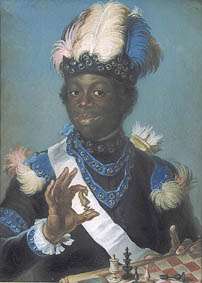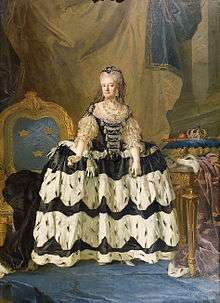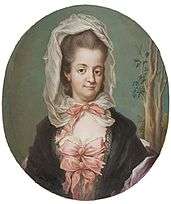Gustav Badin
| Gustav Badin | |
|---|---|
 Badin by Gustaf Lundberg | |
| Born |
Couchi 1747 or 1750 Africa or Saint Croix |
| Died |
1822 (aged c. 75 or c. 72) Sweden |
| Other names |
Adolf Ludvig Gustav Fredrik Albert Badin or Badin |
| Occupation | Butler: to Queen Louisa Ulrika of Prussia; then Princess Sophia Albertine of Sweden |
| Known for | Court Secretary |
| Spouse(s) | Elisabeth Svart, Magdalena Eleonora Norell. |
Adolf Ludvig Gustav Fredrik Albert Badin, né Couchi, known as Badin, (1747 or 1750 – 1822), was a Swedish court-servant and diarist, originally a slave, butler of first Queen Louisa Ulrika of Sweden and then Princess Sophia Albertine of Sweden. His original name was Couchi, but he was commonly known as Badin, which means mischief-maker or trickster.
Background
Badin was born either in Africa or in the Danish island Saint Croix; he himself said that the only thing he remembered about his past was his parents' hut burning, but it is not known whether this happened in Africa or in Saint Croix. He was taken to Europe, probably on a Danish East Indies ship, from where he was bought by a Danish captain, who gave him to statesman Anders von Resier, who, in turn, gave him as a present to the Queen of Sweden, Louisa Ulrika of Prussia, in 1757. The date of his birth is not really known; 1747 is a traditional year, but within the court and the order of the Timmerman, the year was reported as 1750, and this is considered more correct by modern historians.
Upbringing at court
The queen decided to make him an experiment in upbringing; she was interested in science and had founded a science academy, where, among other topics, the origin of man and civilisation was discussed, such as the nature of "savages", the noble savage and the natural human, and in Badin, she saw an opportunity to test the theories of Rousseau and Linné. She instructed him in Christianity and taught him to read and write, but after this, he was allowed to live entirely according to his own will and judgement. He grew up as a playmate of the children in the royal family, who were brought up in a much more restricted way than he was, and was allowed to speak to them in a natural way and even fight and tease them, which was considered scandalous. He knew all the secret passages within the royal castles and, as it was said, all the secrets within its walls. Contemporary diaries describe how he climbed on the chairs of the king and queen, called everyone "you" instead of using their titles, talked rudely to the nobility and ridiculed religion when interrogated about the bible by Countess Brahe, which made everyone laugh; he was very witty and verbal.
Adulthood
On 11 December 1768, he was baptised in the chapel of Drottningholm Palace with the entire royal family, except Prince Charles, as his godparents. As an adult, he was the butler of first the queen and after her death in 1782 to the Princess Sophia Albertina.
When the queen lay on her death-bed in her country residence, she sent Badin to Stockholm with the key to her files. After her death, Badin acquired the files and handed them in the custody of prince Fredrick Adolf and princess Sophia Albertina, who burnt them[1] The young king, Gustav III of Sweden, became enraged. They had an argument and the king said; "Do you not know, you black person, that I can make you pay with your head?" He replied: "My head is in the power of your Majesty, but I could not act in a different way."[2]
The relationship with his royal foster-siblings was otherwise described as good, no matter that he called King Gustav "Gustav the Willen" and Duke Charles "Mr Tobacco". He was close to his foster-sister, Sophia Albertina, and wrote a poem for her on her birthday (1764):
"I, one of the Black People
Unfamiliar with this country's customs
Make a wish from my heart
To our Princess too."
Their relationship was good, though she hesitated as to whether she could keep him after 1787, when she had been made abbess of Quedlinburg, a convent.
Badin was married twice but died childless; the rumors that he was the father of the alleged secret daughter of Sophia Albertina have never been confirmed. He married Elisabet Svart (d. 1798) in 1782 and Magdalena Eleonora Norell in 1799[3] Badin sometimes helped the court poet Bellman to compose verses for special occasions, and some of them were published in his name. Badin participated in plays at the French Theatre in Bollhuset; he is listed as a dancer in a ballet in the 1769-70 season and played the main part in Arlequin Sauvage in the 1770–71 season, a play in which a "savage" meets civilization, and an erotic play by Marivaux.

Badin collected an extensive library consisting of some 900 volumes, mostly in French. It was sold in Stockholm in the year of his death 1822 with a printed catalogue. This makes him one of the first recorded book collectors of African origin.
The social position of Badin was not quite clear; he was given several titles, such as chamberlain, court secretary, ballet master and official; he never used the title "official", which King Gustav gave him, and told him; "Have you ever seen a black official?", but preferred to call himself farmer, as he owned two farms. He was also elected to the orders of Par Bricole, Svea Orden, Timmermansorden and the Freemasons.[4]
He was described as an intelligent and reliable person with self-confidence, and though he was informed about many of the secrets of the royal family and the court, he never revealed anything, and was very loyal to the royal house throughout his entire life. His diaries, written in French, are preserved in the library of the Uppsala University.
During his later life, he was reportedly supported financially by princess Sophia Albertina[5]
Context
Badin was not the only African brought to Sweden during the 18th century; in the churches of Stockholm, other "morians" (which was a name for black people) were baptised, such as Johannes in 1757, Adolf Ulrik in 1759 and Zamore (also a court slave) in 1772, Vulcain in the Royal Chapel in Stockholm in 1776 and a woman, Daphne, in Småland in 1783. Duke Charles bought "the most beautiful morian Sweden have ever seen" according to Gjörwell in 1771, and in 1802, a black teenager of the Duke, Figaro, was involved in a love affair at court. Also non-black slave converts are recorded, such as Pluto from India in 1785 and Native Americans in the presence of nobility and a large gathering of the people. Officially, they would not have been slaves, as it was illegal in Sweden.
Badin in literature
Badin is a character in the novel Morianen by Magnus Jacob Crusenstolpe in 1838, where he was described as the participator in all the secrets and greater events of the royal family, from the revolution of 1772 to the deposition of 1809. Though this was exaggerated, it was nevertheless a more-or-less true image of him.
See also
Notes
- ↑ Carl Forsstrand (Swedish): Sophie Hagman och hennes samtida. Några anteckningar från det gustavianska Stockholm. (English: Sophie Hagman and her contemporaries. Notes from Stockholm during the Gustavian age") Second edition. Wahlström & Widstrand, Stockholm (1911)
- ↑ Carl Forsstrand (Swedish): Sophie Hagman och hennes samtida. Några anteckningar från det gustavianska Stockholm. (English: Sophie Hagman and her contemporaries. Notes from Stockholm during the Gustavian age") Second edition. Wahlström & Widstrand, Stockholm (1911)
- ↑ Carl Forsstrand (Swedish): Sophie Hagman och hennes samtida. Några anteckningar från det gustavianska Stockholm. (English: Sophie Hagman and her contemporaries. Notes from Stockholm during the Gustavian age") Second edition. Wahlström & Widstrand, Stockholm (1911)
- ↑ Badin – ett experiment i fri uppfostran Populär Historia 1/1996 (Badin - an experiment in free upbringing) (Swedish)
- ↑ Carl Forsstrand (Swedish): Sophie Hagman och hennes samtida. Några anteckningar från det gustavianska Stockholm. (English: Sophie Hagman and her contemporaries. Notes from Stockholm during the Gustavian age") Second edition. Wahlström & Widstrand, Stockholm (1911)
References
- Svenskt biografiskt handlexikon (Swedish)
- Nordisk familjebok (Swedish)
- Ingvar Andersson: Gustavianskt (The Gustavian age) (Swedish)
- Signum svenska kulturhistoria: Frihetstiden (The age of liberty) (Swedish)
- Herman Lindquist: "Historien om Sverige. Gustavs dagar" (History of Sweden. The days of Gustav) (Swedish)
- "Svenska män och kvinnor" (Swedish men and women. Dictionary) (Swedish)
- Anna Ivarsdotter Johnsson och Leif Jonsson: "Musiken i Sverige. Frihetstiden och Gustaviansk tid 1720-1810." (Music in Sweden. The age of liberty and the Gustavian age) (Swedish)
- Gidlunds förlag: "Ny svensk teaterhistoria. Teater före 1800" (New Swedish theatre history. Theatre before 1800) (Swedish)
- Eric Basir: "Badin's Diary: An English Translation."

